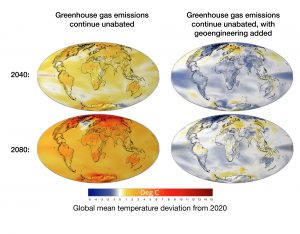6 November 2017
New approach to geoengineering simulations is significant step forward
Posted by Joseph Cariz
Modeling strategy allows scientists to explore ways to limit warming, reduce side effects
By Laura Snider
Using a sophisticated computer model, scientists have demonstrated for the first time that a new research approach to geoengineering could potentially be used to limit Earth’s warming to a specific target while reducing some of the risks and concerns identified in past studies, including uneven cooling of the globe.
The scientists developed a specialized algorithm for an Earth system model that varies the amount and location of geoengineering — in this case, injections of sulfur dioxide high into the atmosphere — that would in theory be needed, year to year, to effectively cap warming. They caution, however, that more research is needed to determine if this approach would be practical, or even possible, in the real world.
The findings from the new research, led by scientists from the National Center for Atmospheric Research (NCAR), Pacific Northwest National Laboratory (PNNL), and Cornell University, represent a significant step forward in the field of geoengineering. Still, there are many questions that need to be answered about sulfur dioxide injections, including how this type of engineering might alter regional precipitation patterns and the extent to which such injections would damage the ozone layer. The possibility of a global geoengineering effort to combat warming also raises serious governance and ethical concerns.
“This is a major milestone and offers promise of what might be possible in the future,” said NCAR scientist Yaga Richter, one of the lead authors. “But it is just the beginning; there is a lot more research that needs to be done.”
Past modeling studies have typically sought to answer the question “What happens if we do geoengineering?” The results of those studies have described the outcomes — both positive and negative — of injecting a predetermined amount of sulfates into the atmosphere, often right at Earth’s equator. But they did not attempt to specify the outcome they hoped to achieve at the outset.
In a series of new studies, the researchers turned the question around, instead asking, “How might geoengineering be used to meet specific climate objectives?”
“We have really shifted the question, and by doing so, found that we can better understand what geoengineering may be able to achieve,” Richter said.
The research findings are detailed in a series of papers published today in a special issue of the Journal of Geophysical Research – Atmospheres.
Mimicking a volcano
In theory, geoengineering — large-scale interventions designed to modify the climate — could take many forms, from launching orbiting solar mirrors to fertilizing carbon-hungry ocean algae. For this research, the team studied one much-discussed approach: injecting sulfur dioxide into the upper atmosphere, above the cloud layer.
The idea of combating global warming with these injections is inspired by history’s most massive volcanic eruptions. When volcanoes erupt, they loft sulfur dioxide high into the atmosphere, where it’s chemically converted into light-scattering sulfate particles called aerosols. These sulfates, which can linger in the atmosphere for a few years, are spread around the Earth by stratospheric winds, forming a reflective layer that cools the planet.
To mimic these effects, sulfur dioxide could be injected directly into the stratosphere, perhaps with the help of high-flying aircraft. But while the injections would counter global warming, they would not address all the problems associated with climate change, and they would likely have their own negative side effects.
For example, the injections would not offset ocean acidification, which is linked directly to carbon dioxide emissions. Geoengineering also could result in significant disruptions in rainfall patterns as well as delays in healing the ozone hole. Moreover, once geoengineering began, if society wanted to avoid a rapid and drastic increase in temperature, the injections would need to continue until mitigation efforts were sufficient to cap warming on their own.
There would also likely be significant international governance challenges that would have to be overcome before a geoengineering program could be implemented.
“For decision makers to accurately weigh the pros and cons of geoengineering against those of human-caused climate change, they need more information,” said PNNL scientist Ben Kravitz, also a lead author of the studies. “Our goal is to better understand what geoengineering can do — and what it cannot.”
Modeling the complex chemistry
For the new studies, the scientists used the NCAR-based Community Earth System Model with its extended atmospheric component, the Whole Atmosphere Community Climate Model. WACCM includes detailed chemistry and physics of the upper atmosphere and was recently updated to simulate stratospheric aerosol evolution from source gases, including geoengineering.

The simulations on the left represent how global temperatures are expected to change if greenhouse gas emissions continue on a “business as usual” trajectory. The simulations on the right show how temperature could be stabilized in a model by injecting sulfur dioxide high into the atmosphere at four separate locations.
Photo credit: University Corporation for Atmospheric Research
“It was critical for this study that our model be able to accurately capture the chemistry in the atmosphere so we could understand how quickly sulfur dioxide would be converted into aerosols and how long those aerosols would stick around,” said NCAR scientist Michael Mills, also a lead author. “Most global climate models do not include this interactive atmospheric chemistry.”
The scientists also significantly improved how the model simulates tropical stratospheric winds, which change direction every few years. Accurately representing these winds is critical to understanding how aerosols are blown around the planet.
The scientists successfully tested their model by seeing how well it could simulate the massive 1991 eruption of Mount Pinatubo, including the amount and rate of aerosol formation, as well as how those aerosols were transported around the globe and how long they stayed in the atmosphere.
Then the scientists began to explore the impacts of injecting sulfur dioxide at different latitudes and altitudes. From past studies, the scientists knew that sulfates injected only at the equator affect Earth unevenly: over-cooling the tropics and under-cooling the poles. This is especially problematic since climate change is warming the Arctic at a faster rate. Climate change is also causing the Northern Hemisphere to warm more quickly than the Southern Hemisphere.
The researchers used the model to study 14 possible injection sites at seven different latitudes and two different altitudes — something never before tried in geoengineering research. They found that they could spread the cooling more evenly across the globe by choosing injection sites on either side of the equator.
Meeting multiple objectives
The researchers then pieced together all their work into a single model simulation with specific objectives: to limit average global warming to 2020 levels through the end of the century and to minimize the difference in cooling between the equator and the poles as well as between the northern and southern hemispheres.
They gave the model four choices of injection sites — at 15 degrees and 30 degrees North and South in latitude — and then implemented an algorithm that determines, for each year, the best injection sites and the quantity of sulfur dioxide needed at those sites. The model’s ability to reformulate the amount of geoengineering needed each year based on that year’s conditions also allowed the simulation to respond to natural fluctuations in the climate.
The model successfully kept the surface temperatures near 2020 levels against a background of increasing greenhouse gas emissions that would be consistent with a business-as-usual scenario. The algorithm’s ability to choose injection sites cooled the Earth more evenly than in previous studies, because it could inject more sulfur dioxide in regions that were warming too quickly and less in areas that had over-cooled.
However, by the end of the century, the amount of sulfur dioxide that would need to be injected each year to offset human-caused global warming would be enormous: almost five times the amount spewed into the air by Mount Pinatubo on June 15, 1991.
Flipping the research question
“The results demonstrate that it is possible to flip the research question that’s been guiding geoengineering studies and not just explore what geoengineering does but see it as a design problem,” said Doug MacMartin, a scientist at Cornell and the California Institute of Technology. “When we see it in that light, we can then start to develop a strategy for how to meet society’s objectives.”
In the current series of studies, adjusting the geoengineering plan just once a year allowed the researchers to keep the average global temperature to 2020 levels in a given year, but regional temperatures — as well as seasonal temperature changes — were sometimes cooler or hotter than desired. So next steps could include exploring the possibility of making more frequent adjustments at a different choice of injection locations.
The scientists are already working on a new study to help them understand the possible impacts geoengineering might have on regional phenomena, like the Asian monsoons.
“We are still a long way from understanding all the interactions in the climate system that could be triggered by geoengineering, which means we don’t yet understand the full range of possible side effects,” said NCAR scientist Simone Tilmes, a lead author. “But climate change also poses risks. Continuing research into geoengineering is critical to assess benefits and side effects and to inform decision makers and society.”
— Laura Snider is the manager of media relations at the University Corporation for Atmospheric Research. This post originally appeared as a press release on the UCAR website.











 GeoSpace is a blog on Earth and space science, managed by AGU’s Public Information staff. The blog features posts by AGU writers and guest contributors on all sorts of relevant science topics, but with a focus on new research and geo and space sciences-related stories that are currently in the news.
GeoSpace is a blog on Earth and space science, managed by AGU’s Public Information staff. The blog features posts by AGU writers and guest contributors on all sorts of relevant science topics, but with a focus on new research and geo and space sciences-related stories that are currently in the news.